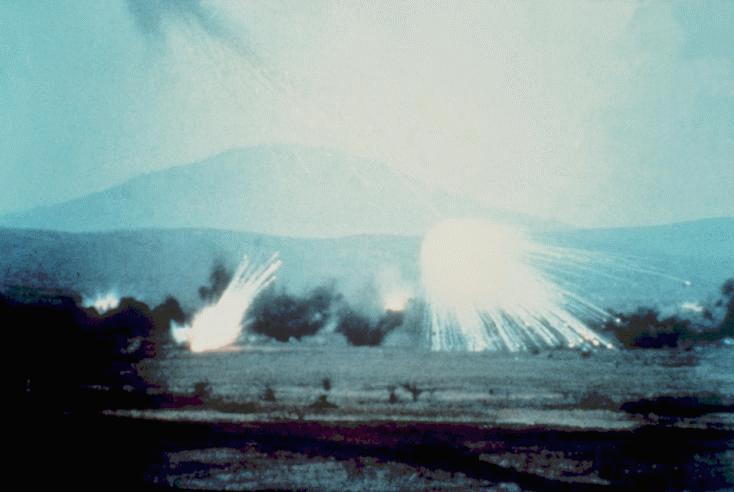White Phosphorus Fact Sheet
|
Elemental phosphorus was first extracted from urine in 1669 by the German alchemist Hennig Brandt. Of the several different types of elemental phosphorus, Brandt produced white phosphorus (WP), which starts to burn upon exposure to air at 30°C (86°F) in moist conditions and at 35-46°C (95-115°F) in dry conditions. WP also glows in the dark and emits smoke. WP can be stored in water to prevent reactions with oxygen. Production: In 2004, according to the United States Geological Survey, the United States mined 163,000,000 metric tons of phosphate rock, mostly for fertilizer. Only a tiny fraction ends up as elemental phosphorous, used in chemical manufacturing, firecrackers, some rat and rodent poisons, and various military munitions. Military Use: The United States military and foreign militaries use WP in grenades, mortar shells, and artillery shells to mark targets, to provide smokescreens for troop movement, to “trace” the path of bullets, and as an incendiary. These items are classified as both smoke ammunitions and incendiary ammunitions. When burning, WP emits smoke that can screen troop movement. This same smoke can act as target markers for aircraft and as signals. WP particles can burn combustible items upon contact until it has completed its reaction with oxygen, which can last up to 15 minutes depending on the munition. As described in the article “The Fight for Fallujah” in the March-April issue of Field Artillery, U.S. military units “fired ‘shake and bake’ missions at the insurgents, using WP to flush them out and HE [high explosives] to take them out.” Laws Regulating Use: According to the Chemical Weapons Convention Schedule of Chemicals, the chemical P4 is neither a toxic chemical nor a precursor to a toxic chemical. Protocol III of The Convention on Prohibition or Restrictions on the Use of Certain Conventional Weapons Which May be Deemed to be Excessively Injurious or to Have Indiscriminate Effects (CCW) prohibits |
Effects: Direct skin contact can lead to thermal burns and chemical burns. WP particles react with oxygen and can cause 2nd and 3rd degree thermal burns. The particles can also enter the body through the burns or other wounds and continue to damage tissues. Chemical burns result from several different compounds produced through WP reactions. These include phosphorus pentoxide which can react with the water in skin and produce corrosive phosphoric acids. Release of WP in an enclosed area can cause asphyxiation due to the decrease of oxygen. Exposure to smoke created by burning WP from military munitions can result in irritation or damage to the eyes, lungs, and throat. Workers exposed to WP over long periods can develop phossy jaw, a condition characterized by the breakdown of the jawbone and delayed-wound healing of the mouth. Treatment: Initially, contaminated clothing should be removed to prevent re-ignition. Treating skin exposed to WP requires irrigation of the contaminated areas or placement of water- or saline-soaked pads. If the area becomes dry, then the WP can re-ignite. In addition, bathing the area in a bicarbonate solution will neutralize any phosphoric acid that may have been produced. Remaining WP particles should be immediately removed surgically. Removal requires care to prevent further contamination of the person or responders. After complete removal, the patient can be treated as a burn victim. |
||
(Sources: American Chemical Society, CDC, eMedicine, NATO, UN Department of Disarmament Affairs, U.S. Army, USGS) |
|||



